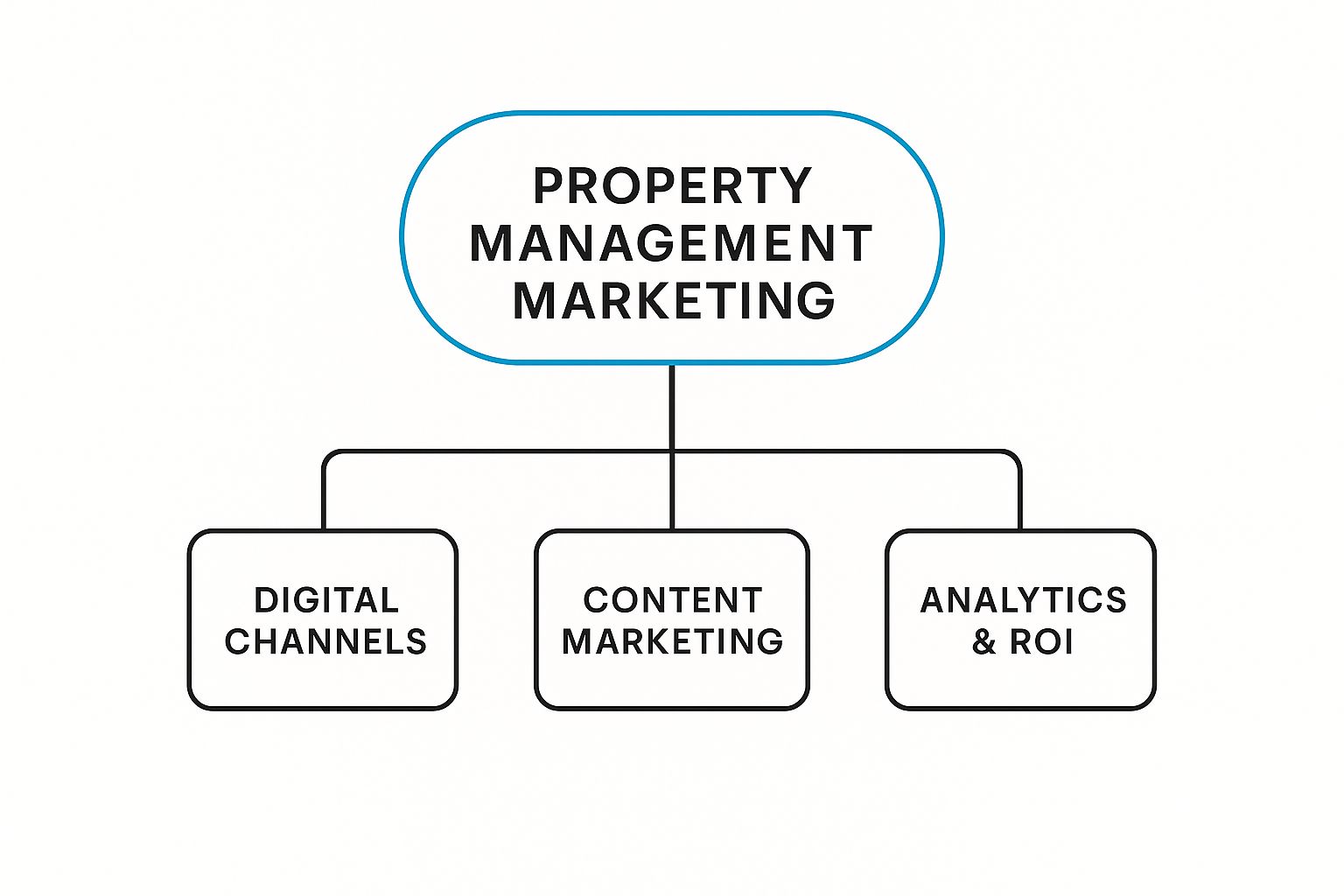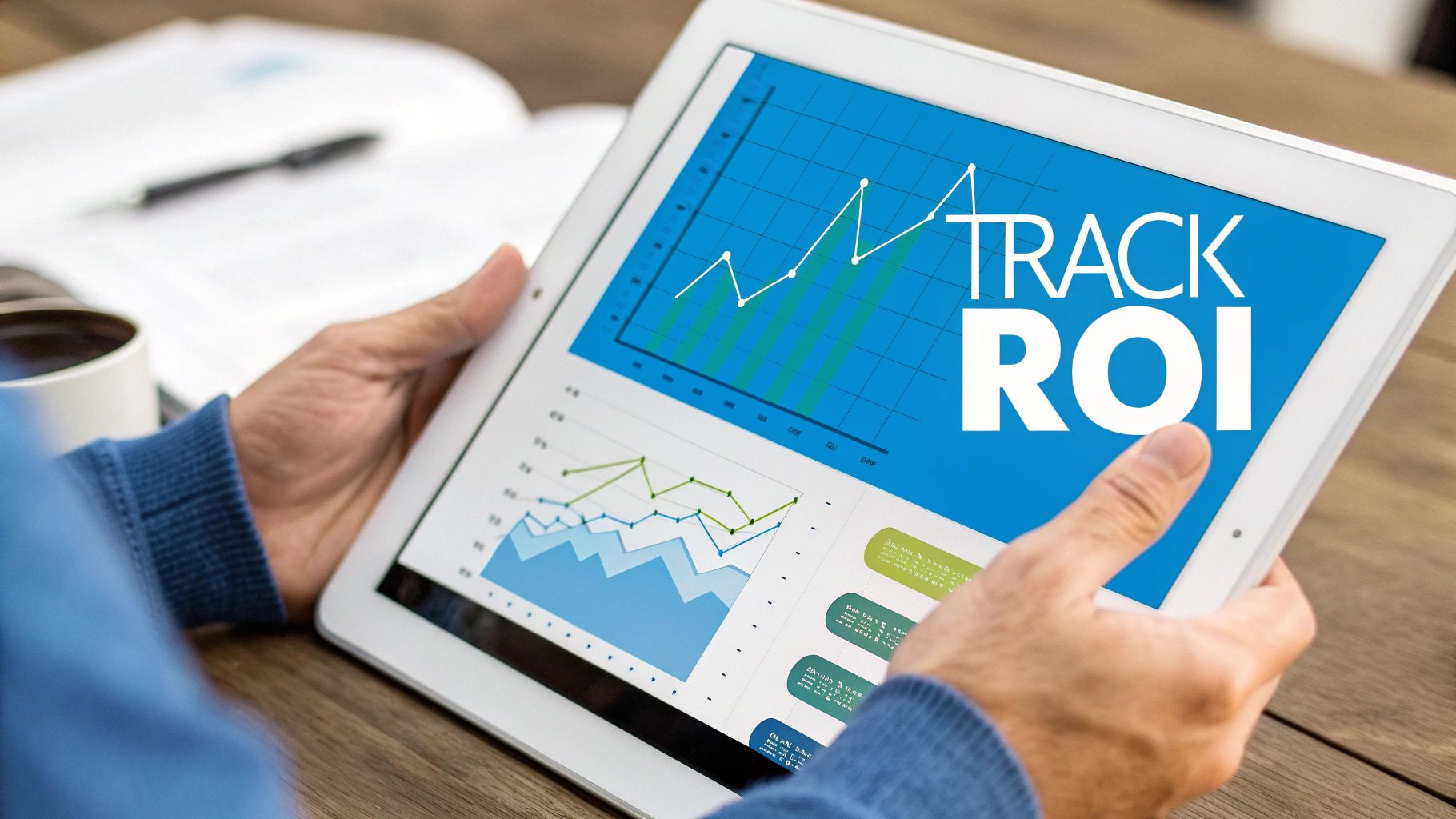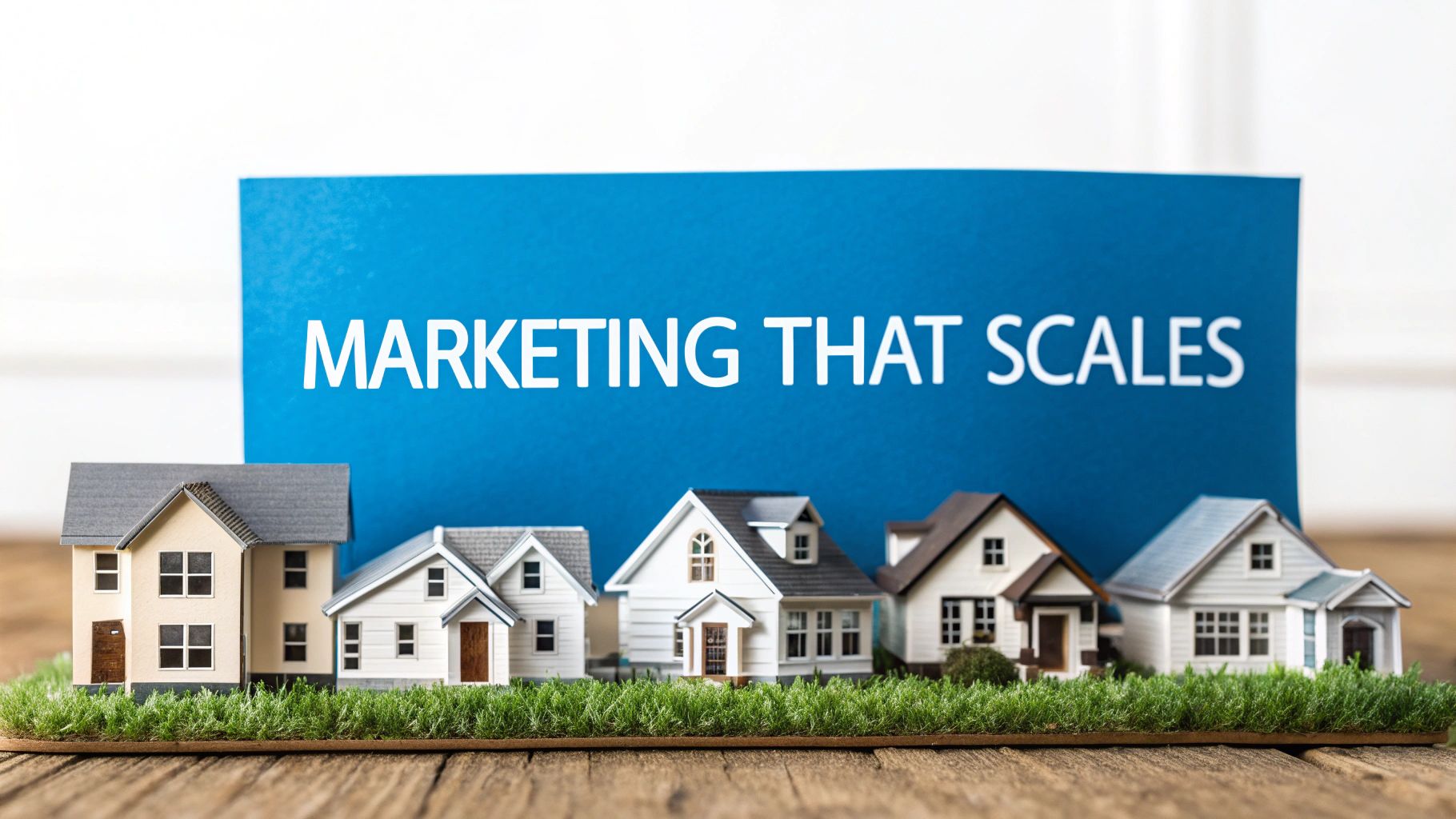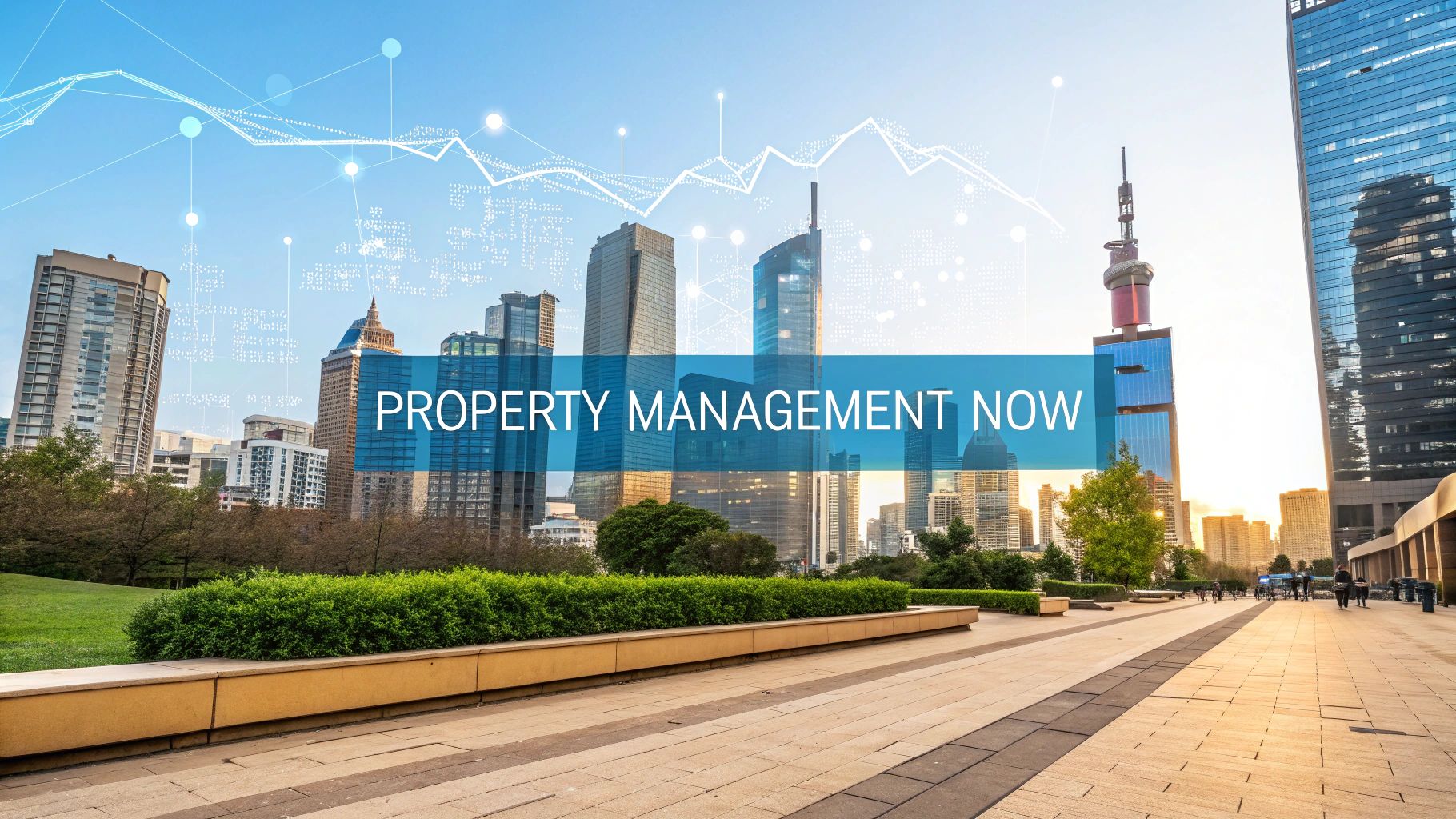If you're managing a portfolio of 100 to 10,000+ units, you know that property management marketing isn't just a line item on your budget—it's the engine that drives your revenue. Its entire purpose is to systematically crush vacancy loss by getting high-quality leads in the door and converting them into signed leases as fast as humanly possible.
This has a direct, measurable impact on core financial metrics like Days on Market (DOM) and your cost-per-door, making it the bedrock of any scalable operation.
Marketing That Drives Revenue, Not Just Leads
In a market this competitive, just filling vacancies isn't going to cut it. For large-scale portfolios managing hundreds or thousands of remote units, the real goal is to engineer a predictable, revenue-driving machine. That means shifting your mindset away from simply generating a pile of leads and toward optimizing the entire leasing funnel for speed and efficiency.
Every single day a unit sits empty, it's a direct financial loss. That cost multiplies frighteningly fast when you're talking about hundreds or thousands of properties. A single day of vacancy across a 1,000-unit portfolio can represent over $50,000 in lost revenue.
The modern approach here is a blend of high-tech automation and smart, strategic human engagement. It's all about building a digital marketing strategy that converts, ensuring every dollar you spend is actively working to shrink those vacancy periods and boost your bottom line.
The New Competitive Landscape
The property management industry is blowing up, with both massive growth and rapid tech adoption. The global market is expected to rocket from $23.03 billion in 2025 to a staggering $38.48 billion by 2034.
Here in the U.S., revenue is projected to hit $98.88 billion by 2029. What this tells us is that we're in a market where operational efficiency and remote management at scale aren't just nice-to-haves—they're essential for survival.
For large portfolios, marketing success isn't measured in likes or follows. It's measured in Days on Market reduction, lead-to-tour conversion rates, and the direct impact on your Net Operating Income (NOI).
The infographic below breaks down the three core pillars of a marketing strategy built for this new reality.

As you can see, a winning strategy rests on a foundation of powerful digital channels, content that actually resonates, and obsessive analytics to prove every bit of your ROI.
To build a marketing operation that can truly support a large and growing portfolio, you need a solid framework. These are the core pillars we see driving success for the most efficient property managers today.
Core Pillars of Scalable Property Management Marketing
These pillars aren't just concepts; they represent a fundamental shift in how to approach marketing at scale, moving from a cost center to a strategic growth driver.
A Closer Look at the Key Components
To put these pillars into practice and build a marketing operation that actually supports a large-scale portfolio, you need to get obsessed with a few key components:
Lead-to-Tour Velocity: This is all about speed. Specifically, how quickly a qualified prospect goes from that first "I'm interested" click to a scheduled tour. For a hot lead, that window might only be a few hours. This is where tech becomes your best friend. Tools like Showdigs can completely bridge that gap, offering the on-demand and self-service tours that match a prospect's sense of urgency, dramatically improving lead-to-tour conversion.
Conversion Rate Optimization: It's time to put every single touchpoint under the microscope. You need to analyze and improve everything to boost the percentage of leads who actually tour and apply. We're talking about everything from the copy on your listings to the timing and content of your automated follow-up emails.
Data-Driven Decision Making: Stop guessing. Use your analytics to understand which channels are delivering the best applicants, not just the most clicks. This is what allows you to intelligently shift your budget and pour resources into the channels that have the biggest impact on reducing your cost-per-door.
Building Your Foundational Marketing Engine
A truly effective property management marketing strategy isn't just a collection of random tactics. It’s a well-oiled, repeatable engine designed to grow with you. Let's move past the generic advice and build a real framework—one with systematized processes that deliver quality and consistency, whether you manage 100 units or 5,000.
It all starts with your website. This is your digital storefront, and it needs to be engineered for one primary purpose: capturing high-intent leads and converting them into tours.

This is where you control the story, show off your properties, and turn casual interest into a signed lease. For any property manager operating at scale, a generic website is a massive missed opportunity. Your site has to be fast, mobile-friendly, and dialed in for local search to grab prospects the moment they start looking.
Define Your Ideal Renter Profile
Before you spend a single dollar on ads, you have to know exactly who you're talking to. And I mean exactly. This goes way beyond basic demographics. An Ideal Renter Profile (IRP) is a detailed portrait of the perfect applicant you want for a specific type of property or neighborhood.
Creating an IRP forces you to get strategic about your audience across your whole portfolio. It ensures your marketing messages actually connect with people, attracting higher-quality applicants and stopping you from wasting money on leads who were never the right fit.
For large, multi-market portfolios, an IRP is non-negotiable. It allows you to tailor marketing campaigns to specific geographic and demographic segments, ensuring maximum relevance and ROI.
Think about these factors when building your IRP:
- Lifestyle Needs: Are they young professionals who need to be close to the city, or are they families looking for a quiet suburban home in a great school district?
- Communication Preferences: Do they expect quick text updates and a self-service portal, or are they looking for a more hands-on, personal touch?
- Key Amenities: What are the absolute deal-breakers? This could be anything from in-unit laundry and pet-friendly policies to smart-home gadgets.
Answering these questions helps you write listing descriptions, ad copy, and even choose property upgrades that speak directly to the renters you want to attract.
Establish a Powerful Brand and Digital Presence
Your brand is so much more than a logo. It's the promise of a consistent, professional experience that you deliver across every single one of your units. A strong brand builds trust and makes your properties pop in a crowded market—a must-have for creating a marketing operation that can scale.
A polished digital presence is how you bring that brand to life. This includes:
- Professional Photography and Videography: High-quality visuals are your most powerful sales tool, period. Listings with professional photos can rent faster and for more money. Grainy, poorly lit smartphone pictures just scream "unprofessional" and will kill a prospect's interest instantly.
- Immersive Virtual Tours: In today's market, virtual tours are no longer a "nice-to-have"—they're essential for remote management operations. They let potential tenants walk through a space from anywhere, on their own time. This pre-qualifies your leads, ensuring that the people who book in-person showings are genuinely interested and improves your lead-to-tour conversion rates.
- Standardized Listing Descriptions: Create templates that highlight key features, benefits, and the things your IRP cares about most. This creates consistency across all your listings and platforms, reinforcing your brand and saving your leasing team a ton of time.
For property managers looking to build a truly solid marketing framework, exploring comprehensive property management marketing plans can give you a structured path to putting these foundational pieces in place. Building this engine is the first step toward a system that doesn't just find tenants—it drives revenue, slashes days on market, and supports your company's growth.
Attracting High-Quality Leads Across All Your Channels
So, where should you put your marketing dollars to get the biggest bang for your buck? For a large portfolio, this isn't about casting the widest net possible. It’s about strategically figuring out where your best, highest-intent leads are actually hiding. The real goal is to build a solid lead funnel that doesn’t rely on just one source, protecting you when the market inevitably shifts.
This means you have to move beyond simply listing properties. You need to actively dominate the channels where your Ideal Renter Profile (IRP) starts their search. A diversified, multi-channel approach is your best bet for creating a steady stream of qualified applicants.

A winning property management marketing strategy makes several channels work together, with each one playing a specific part in attracting and converting the right tenants.
Dominate Local Search with Smart SEO
Search Engine Optimization (SEO) is hands-down your most powerful tool for capturing organic leads who are ready to sign a lease. When a potential tenant searches "three-bedroom apartment for rent in [Your City]," you absolutely have to be at the top of those results. For large portfolios, this means getting serious about local SEO for every market you operate in.
Here's where to focus your efforts:
- Google Business Profile (GBP) Optimization: For every market or large community you serve, you need a fully built-out GBP listing. That means accurate info, great photos, a steady stream of positive reviews, and regular posts about your available units.
- Localized Website Content: Create specific pages on your website for each city or neighborhood. These pages should be packed with local keywords and talk about all the things renters care about—amenities, schools, and the local lifestyle.
- Schema Markup for Rentals: This is a bit more technical, but it’s a game-changer. Use structured data (schema) on your property listing pages. It helps search engines understand details like rent price, availability, and bedroom count, which can get you those nice, enhanced search result listings.
For enterprise-level portfolios, SEO is not a one-and-done task. It's a constant cycle of checking your rankings, tweaking content for local searches, and making sure every single property is visible the moment a target renter starts looking.
This consistent effort in SEO builds a long-term asset that keeps delivering qualified leads at a much lower cost-per-door than paid ads.
Run Targeted Ads on Social Media
While SEO grabs people who are actively searching, social media lets you find those who aren't even looking yet. Platforms like Facebook and Instagram are incredibly good at zeroing in on specific renter demographics with almost surgical precision.
Forget generic "for rent" ads. You can create campaigns that target users based on life events (like "recently moved"), interests (like "luxury apartments"), and even income levels. This way, your marketing budget is only spent reaching people who are actually a great fit for your properties.
A solid social media ad strategy for a large portfolio includes:
- Retargeting Website Visitors: Show ads to people who’ve already browsed your website or looked at specific property pages. It’s a simple way to keep your brand top-of-mind.
- Lookalike Audiences: Take a list of your best current tenants, upload it, and let the platform create a "lookalike" audience to find new prospects with similar traits.
- Dynamic Ads for Rentals: Automatically show ads for specific available units to users who have shown interest in properties just like them.
Get the Most Out of Internet Listing Services
Internet Listing Services (ILS) like Zillow, Apartments.com, and Zumper are a necessary part of the game. But the secret to success at scale isn’t just being on them—it’s about optimizing your listings to get the best ROI.
Too many property managers just syndicate their listings and hope for the best. The strategic move is to analyze the performance of each ILS. Figure out which ones are actually delivering qualified leads and signed leases, not just empty clicks. As marketing experts at places like Fourandhalf often advise, you need to track your lead-to-lease conversions for each channel to know if the spending is worth it.
This data lets you double down on the platforms that work and cut the ones that don't, which directly improves your cost-per-door. A diversified strategy like this builds a resilient lead funnel, protecting your portfolio from market swings and ensuring you always have a steady flow of high-quality applicants.
Optimizing Your Funnel From Lead To Lease
Getting leads in the door is just the beginning. The real test—where your operations either make or break your bottom line—is how well you turn those interested prospects into tenants with signed leases.
This is your leasing funnel. And when you’re managing a large portfolio, success boils down to two things: speed and efficiency. Every delay, every manual touchpoint, every bottleneck is a cash drain that gets amplified across hundreds or even thousands of properties without onsite staff.
A slow response gives a hot lead time to book a tour with your competitor down the street. A clunky scheduling process creates friction and causes them to drop off entirely. For any serious property manager, tightening up this funnel isn't just a marketing goal; it’s an operational imperative that directly impacts revenue.
At scale, the speed of your leasing funnel is a direct reflection of your portfolio's financial health. The difference between a seven-day and a three-day lead-to-lease cycle can mean tens of thousands of dollars in recovered revenue each month.
The goal is to build a system that's both lightning-fast and consistently reliable, flipping a vacant unit from a daily liability into a performing asset in record time.
Slashing Days On Market Through Speed To Lead
If there’s one single factor that has the biggest impact on reducing Days on Market (DOM), it’s your speed-to-lead. Think about it: a lead who has to wait hours for a reply is already a cold lead. But a lead who gets an instant, helpful response and a link to book a tour? They’re already halfway to filling out an application.
This is where automation becomes your secret weapon. The first step is setting up automated, but still personal, responses. When a prospect reaches out at 10 PM on a Tuesday, they shouldn't have to wait for your office to open the next day. An automated system can immediately thank them, confirm the property is available, and—most importantly—give them a link to schedule a showing. To see how this works in practice, check out our guide on how marketing automation streamlines your leasing process.
The next big leap is using on-demand tech to offer same-day showings. This directly meets the modern renter’s expectation for instant gratification. Tools like Showdigs make this possible by pairing smart scheduling software with a network of on-demand agents. This allows a prospect to tour a property within hours of their initial click, not days. This massive acceleration of the lead-to-tour timeline is a complete game-changer for cutting down DOM.
The Financial Impact of Shaving Days Off Your Vacancy Rate
To really grasp the value of a fine-tuned funnel, let's do some quick math. Every single day a unit sits empty, it's costing you real money.
Vacancy Cost Calculation Example:
- Portfolio Size: 1,000 units
- Average Monthly Rent: $1,800
- Daily Rent (Cost of Vacancy): $1,800 / 30 days = $60 per day, per unit
- Average Vacancy Rate: 5% (50 units vacant at any time)
- Total Daily Portfolio Vacancy Cost: 50 units * $60/day = $3,000 per day
Now, what if you implemented on-demand showings and automated follow-ups and managed to cut your average DOM by just four days?
- Annual Revenue Recovered: $3,000/day * 4 days * 12 months = $144,000
That isn't a hypothetical number. That's $144,000 in real revenue flowing directly back into your NOI, all from improving just one part of your leasing process. This is exactly why investing in funnel optimization tech delivers such a massive return for large-scale operators.
Improving Lead To Tour Conversion Rates
Getting more leads to actually show up and tour your properties is a battle won on convenience and communication. With competition getting stiffer, property managers are paying attention. A recent report showed that 44% of property management companies increased their promotional spending ahead of 2025. This investment comes at a tricky time; while 629,000 new units came online in the U.S. in 2024, that number is expected to drop to 497,000 in 2025. This signals a tighter market even as renter demand starts to cool. You can read the full 2025 industry report for the complete picture.
To make your properties the obvious choice, focus on these strategies to get more people through the door:
- Offer Flexible Showing Options: Give prospects what they want. Offer agent-led tours, secure self-guided tours, and even live virtual tours. The more options you provide, the higher your lead-to-tour conversion rate will be.
- Implement a Smart Follow-Up Cadence: Use automation to send helpful reminders. A simple text message an hour before a tour can make a huge difference in reducing no-shows.
- Capture Feedback Immediately: As soon as a tour ends, automatically send a request for feedback. It makes the prospect feel valued and gives you priceless intel to improve your listings and showings.
By obsessively improving every micro-step from that first click to the final lease, you stop treating marketing as an expense and start turning it into a powerful, revenue-generating machine that grows right alongside your portfolio.
Leveraging Your PropTech Stack For Scale
If you’re managing a large-scale portfolio, technology isn't just a nice-to-have—it's the engine that drives your entire operation. Building the right PropTech stack is what creates a powerful, seamless marketing and leasing machine that can actually grow with you.
This isn’t about chasing every shiny new app. It’s about building a connected ecosystem where every piece of your enterprise property management software works together to speed up leasing and cut down on the operational headaches that slow you down.
Think of your Property Management System (PMS) as the central nervous system. It’s the database holding all your critical property, tenant, and financial info. A PMS is powerful on its own, but its true potential is unlocked when you plug in specialized tools that amplify what it can do. The goal here is smart automation, letting technology handle the repetitive, low-value tasks so your team can focus on what they do best: building relationships and closing deals.
This mix of smart tech and human oversight is how you build a leasing operation that’s both infinitely scalable and deeply personal. It’s the secret to delivering a consistent, top-notch experience whether you have 500 doors or 5,000.
Architecting Your Scalable Tech Stack
Building a high-performance tech stack is a strategic, layered process. Each piece of software should solve a specific problem in your leasing funnel, from the moment a lead comes in to the final lease signing. The endgame is a smooth, frictionless workflow where data flows between systems automatically, handling tasks and giving you the insights you need at every step.
Here’s a blueprint for a modern PropTech stack built for growth:
- Core System (Your PMS): This is your single source of truth. Every other tool should integrate with your PMS (like Appfolio or RentManager) via API to pull data, ensuring everything is consistent and you’re not wasting time on duplicate data entry.
- Lead Management & CRM: While some PMS platforms have basic CRMs, a dedicated tool gives you much more robust automation for nurturing leads, setting up follow-up sequences, and tracking every single conversation.
- Showing & Tour Management: This is where you can make the biggest dent in your Days on Market (DOM). A dedicated platform like Showdigs automates tour scheduling, offers self-guided showings, and can even dispatch on-demand agents to show a property—drastically speeding up how quickly you get a prospect through the door.
- Business Intelligence (BI) Tools: You can't optimize what you can't see. BI tools connect to your PMS and other systems to create dashboards that track your most important KPIs, like cost-per-door, which lead sources are working, and DOM trends across different markets.
For an enterprise portfolio, the goal isn't just to have technology, but to have an integrated ecosystem. A lead from an ILS should automatically trigger a response from your CRM, which then offers a tour through your showing platform, with all the activity logged right back in your PMS. That’s a system that can scale.
Balancing Automation With The Human Touch
Technology is a powerful tool, but let's be real—property management is still a people business. The industry is definitely being shaped by tech like AI, chatbots, and virtual tours, but the most successful companies are the ones that balance all that automation with a personal, human connection.
As of 2025, there are about 910,000 property management professionals in the U.S., with nearly 720,000 focused on residential properties. The workforce is predominantly female (59.5%), which really speaks to the service-first nature of this industry and how much interpersonal skills matter. You can dig into more industry trends like this over at perq.com.
The best PropTech stacks are the ones that free up your skilled team to do what machines can't.
This strategic split is how you get hyper-efficient without losing the personal touch that builds trust and keeps great tenants around for the long haul. Your tech handles the volume and speed, while your team provides the expertise and relationship-building that makes your company stand out. That synergy is the real foundation of a scalable and profitable leasing operation.
Measuring Marketing Success and Proving ROI
For any property management company that lives and breathes by its numbers, proving the value of your marketing isn't just a nice-to-have—it's an operational necessity. This isn't about chasing vanity metrics like website traffic or piling up social media followers. It’s about connecting every marketing dollar spent directly to real business outcomes like cost-per-door reduction and NOI improvement.
The goal is to build a performance dashboard that speaks the language of your stakeholders: revenue, cost savings, and profitability. We need to move past surface-level data and focus on the numbers that truly reveal the financial health of your leasing operations.
Key Metrics for Enterprise Portfolios
When you're managing a large-scale portfolio, your marketing dashboard should be built around a few critical KPIs that cut right to the chase. These metrics give you a crystal-clear view of your leasing funnel's health and how effectively your budget is working.
You need to be laser-focused on:
- Cost Per Door (CPD) / Cost Per Acquisition (CPA): This is your all-in cost to get one signed lease. Tracking CPA helps you pinpoint which marketing channels give you the most bang for your buck and which ones are just draining your budget.
- Lead-to-Lease Conversion Rate: Of all the people who inquire about a property, what percentage actually end up signing on the dotted line? This master metric tells you how efficient your entire process is, from that first click to handing over the keys.
- Days on Market (DOM): This is the ultimate measure of speed. Nothing fights vacancy loss and boosts revenue faster than shrinking your DOM.
The most effective marketing teams are obsessed with the financial impact of every single day a unit sits empty. They can confidently tell you that reducing DOM by just one day across a 1,000-unit portfolio can recover thousands of dollars in lost revenue.
To keep these metrics front and center, a simple table can make all the difference.
Enterprise PM Marketing KPIs and Benchmarks
Here’s a breakdown of the essential metrics large property management companies should be tracking to measure the real-world effectiveness of their marketing.
Tracking these benchmarks helps you understand not just how you’re performing, but how you stack up against the best in the business. It’s about setting ambitious but achievable goals.
Calculating True Marketing ROI
Proving your ROI is all about connecting your marketing efforts to tangible financial results. The simplest way to do this is by measuring the value you created (like reducing vacancy loss) against what you spent on your marketing initiatives.
This approach gives you a powerful story to tell when it’s time to justify budgets or ask for investment in new tech. To get a better handle on the numbers behind your tech stack, you can unlock marketing automation ROI secrets from seasoned pros.
Ultimately, a successful marketing program doesn’t just bring in leads; it creates a measurable financial lift for the entire business. For more practical ideas, check out these 8 ways to boost ROI in your property management operations. When you track these core metrics, you can confidently prove the immense value of every dollar you invest in marketing.
Frequently Asked Questions

Let's tackle some of the tough, real-world questions that come up when you're building out a marketing plan for a large-scale portfolio.
How Much Should a Large Portfolio Budget for Marketing?
Throw out the idea of using a generic percentage. The most successful property management companies have stopped thinking of marketing as a cost center and started treating it as an investment to crush vacancy costs.
Your best bet is to budget based on performance. First, figure out your current Cost Per Lease (CPL) and what you're losing to vacancy. Your marketing budget should then be aimed squarely at funding the channels and tech proven to bring those numbers down. Many enterprise-level firms will allocate funds per door or as a percentage of projected annual rent, but the focus is always on tactics that directly shrink your Days on Market (DOM).
What Is the First Technology to Invest in for Maximum Impact?
Assuming you have a solid Property Management System (PMS) in place, the next investment with the biggest and fastest payoff is technology that shortens your lead-to-lease timeline. Specifically, a dedicated showing management platform delivers the most immediate and significant ROI.
Investing in technology that enables self-service tours and on-demand showings directly addresses the biggest sources of lost revenue—vacancy and inefficiency. It radically improves lead-to-tour conversion rates and slashes DOM.
Think about it: this one move solves multiple bottlenecks in your leasing funnel, from how fast you respond to a new lead all the way through getting them on a tour. This is the fastest path to reducing days on market for a distributed portfolio.
How Can We Maintain Brand Consistency Across Different Markets?
Keeping your brand looking and feeling the same across a scattered, multi-market portfolio is all about having a centralized strategy with decentralized execution. The foundation for this is a comprehensive brand playbook.
This playbook needs to be the one and only source of truth for:
- Visual Identity: Hard and fast rules for your logos, color schemes, and the style of your photography.
- Messaging & Tone: Standardized templates for listing descriptions and clear guidelines for how your team communicates.
- Operational Standards: Consistent processes for everything, from lead follow-up protocols to what the in-person showing experience should feel like.
You then arm your local teams with these templates and tools, while a central marketing function runs regular audits to maintain quality. This way, every single prospect gets the same professional experience, no matter which city they're in.
Accelerate your entire leasing funnel and slash Days on Market with Showdigs. Our AI-backed leasing automation platform is the fastest path from lead to lease for distributed portfolios, combining smart software with a network of on-demand agents to get your properties leased faster. Learn how Showdigs can transform your operations.







